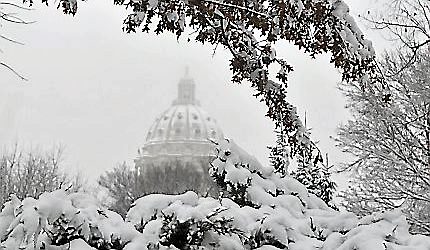GREEN BAY — It’s hard to effectively sum up how bad the Vikings were after halftime in the embarrassing 23-6 loss to the Green Bay Packers on Sunday afternoon at Lambeau Field. The ineptitude displayed might go down as the worst 30 minutes that will ever be put forth under head coach Kevin O’Connell.
It was a total system failure across the board for the Vikings after rookie returner Myles Price muffed a punt near his own goal line.
That opened the floodgates as quarterback J.J. McCarthy was forced to take on a heavier workload than he could bear. He looked completely overwhelmed for prolonged stretches while struggling to put together consecutive positive plays from scrimmage.
Here are some takeaways from the game:
The game looks too big for J.J. McCarthy right now
It’s a major problem that McCarthy seems to be regressing.
Though growing pains were to be expected for a young signal caller, there aren’t a lot of things to suggest he’s actually getting better. At least not at the moment. He completed 12 of 19 passes for 87 yards, no touchdowns, and a pair of interceptions for the Vikings against the Packers. He also appeared to be visibly rattled down the stretch
There was clearly a concerted effort from O’Connell in the early stages to limit the amount of times McCarthy had to throw the ball. He relied on the running game more than usual as a way to control the pace of the game as best he could.
The game script eventually called on McCarthy to shoulder more of the load, however, and he proved time and time again that he wasn’t up for the challenge. Not only did he turn the ball over twice, his pocket presence disappeared while taking a handful of sacks.
Is it going to get better for McCarthy in the short term? It’s hard to see a pathway at this point.
The offensive line can’t stay healthy
The highly anticipated return of center Ryan Kelly meant the Vikings finally had their entire projected starting offensive line playing together for the first time. That positive development didn’t last very long as left tackle Christian Darrisaw and rookie left guard Donovan Jackson both left the game with injuries.
The loss of both players up front came with the Vikings already getting dominated by the Packers in the trenches.
The impact that star edge rusher Micah Parsons brings to the table was palpable as he lived in the backfield against a depleted offensive line across from him. He finished the game with a pair of sacks and also paved the way for a couple of sacks from defensive tackle Devonte Wyatt.
The extent of the injures for Darrisaw and Jackson are still unclear. It would be a crushing blow if either player had to miss an extended period of time.
The defense needs to start forcing turnovers
It wouldn’t be fair to put too much blame on the defense when considering the way the Vikings managed to make life hard on the Packers in some respects.
It wasn’t an prolific outing for quarterback Jordan Love through the air he only completed 12 of 21 passes for 139 yards. It almost felt like the Vikings were content to let backup running back Emanuel Wilson beat them and he did to a degree by posting 28 carries for 107 yards and a pair of touchdowns.
The more glaring issue for the Vikings is the lack of turnovers being created by the defense. After finishing tied for the league lead in takeaways last season, they have yet to reach double digits this season. That’s simply not good enough from a unit that’s identity is predicated on takeaways.
The last time the Vikings forced a turnover in any capacity came a few weeks ago when linebacker Blake Cashman forced a fumble in the upset win over the Detroit Lions.
The mistakes for Myles Price are adding up
The game got turned upside down for the Vikings when Price lost a fumble on a punt return shortly after halftime. After deciding not to call a fair catch near his goal line, Price accidentally let the ball hit him. That resulted in a turnover and the Vikings never fully recovered against the Packers.
The blunder from Price wasn’t too far removed from a couple of weeks ago when he lost a fumble on a kickoff return in a loss to the Baltimore Ravens. As much as the undrafted free agent has shown flashes of brilliance, he’s also had a number of costly errors to start his career. That trend can’t continue if Price wants to keep his spot on the roster.
The excellence of Will Reichard shouldn’t be overlooked
The lone bright spot from the game was the performance from kicker Will Reichard. He was the only reason the Vikings scored any points against the Packers.
After making fact a 52-yard field goal, Reichard followed it up by making a 59-yard field goal. He made both kicks look like chip shots despite the fact that he was kicking in a venue that isn’t exactly kind to kickers.
There’s no doubt the Vikings got it right by using a draft pick on Reichard once upon a time. He’s slowly but surely establishing himself among the best players at his position.
Related Articles
Packers stopped the run, then teed off on Vikings’ J.J. McCarthy
Frederick: This Vikings’ offense is woeful, and seems to be getting worse
Vikings completely dominated by Packers in embarrassing loss
Vikings at Packers: What to know ahead of Week 12 matchup
The Loop Fantasy Football Update Week 12: Last-minute moves




